Cosenza
| Cosenza | |
|---|---|
| Comune | |
| Città di Cosenza | |
|
Panoramic View | |
.svg.png) Cosenza within the Province of Cosenza | |
 Cosenza Location of Cosenza in Italy | |
| Coordinates: 39°18′N 16°15′E / 39.300°N 16.250°ECoordinates: 39°18′N 16°15′E / 39.300°N 16.250°E | |
| Country | Italy |
| Region | Calabria |
| Province / Metropolitan city | Cosenza (CS) |
| Frazioni | Donnici, Sant'Ippolito, Borgo Partenope, Muoio |
| Government | |
| • Mayor | Mario Occhiuto |
| Area | |
| • Total | 37 km2 (14 sq mi) |
| Elevation | 238 m (781 ft) |
| Population (30 April 2009) | |
| • Total | 71,000 |
| • Density | 1,900/km2 (5,000/sq mi) |
| Demonym(s) | Cosentian (Italian: Cosentino) |
| Time zone | CET (UTC+1) |
| • Summer (DST) | CEST (UTC+2) |
| Postal code | 87100 |
| Dialing code | 0984 |
| Patron saint | Our Lady of the Pillar |
| Saint day | 12 February |
| Website | Official website |
Cosenza (pronounced [koˈzɛntsa] ![]() listen ) is a city in the Calabria region of Southern Italy. The city proper has a population of 71,000, while the urban area counts over 268,000[1] inhabitants. It is the capital of the Province of Cosenza, which has a population of around 735,000.
listen ) is a city in the Calabria region of Southern Italy. The city proper has a population of 71,000, while the urban area counts over 268,000[1] inhabitants. It is the capital of the Province of Cosenza, which has a population of around 735,000.
The ancient town is the seat of the Cosentian Academy, the second academy of philosophical and literary studies to be founded in the Kingdom of Naples (1511) and one of the oldest in Europe. To this day, the city remains a cultural hub with several museums, theatres, libraries and the University of Calabria.
Geography and Climate
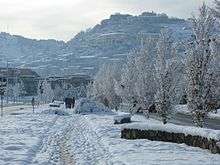
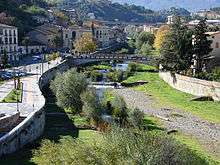
Located at the confluence of two historical rivers, the Busento and the Crathis, Cosenza stands 238 m above sea level in a valley between the Sila plateau and the coastal range of mountains. The old town, overshadowed by its Norman castle, descends to the river Crathis. The modern city lies to the north, beyond the Busento, on level ground.
Almost completely surrounded by mountains, Cosenza is subject to a microclimate scarcely influenced by the Mediterranean Sea, with cold winters and hot summers.
History
Origins
The ancient Consentia, capital of the Italic tribe of the Bruttii, was a bulwark of the Italic people against the Hellenic influences of the Ionian colonies. It was in this province that the Battle of Pandosia was fought, in which a small Italic army composed of Bruttii and Lucanians defeated Alexander the Great's uncle, Alexander of Epirus. Over the centuries, Cosenza maintained a distinctive character, which marked it out among the cities of the region. Under Emperor Augustus it became an important stopover on the Roman route via Popilia, which connected Calabria to Sicily. During the Roman Empire, although merely a colonia, the town benefited from municipal privileges.
Alaric's legendary tomb
In 410 AD Alaric I, king of the Visigoths sacked the city of Rome and became the first foreign enemy to capture the city in over 800 years. After leaving Rome, Alaric had amassed a great amount of treasure from his conquest of the city.
According to the Gothic historian Jordanes,[2] After sacking Rome Alaric left and headed south with his troops until reaching the area of Cosenza, where he died. No one is certain how this happened: Some believe he contracted a disease that took his life, while others feel that his death came from an attack by enemy forces. In any case, his troops honored their king by burying him in a tomb in the city. His burial place is said to have been at the confluence of the Busento and Crathis rivers. A horde of slaves were used to divert the water from the Busento, allowing them to dig a tomb large enough for Alaric, his horse and all of the treasure amassed from his conquests in Rome. Once the tomb was completed, the river was returned to its bed and the tomb covered with water. Then, to ensure that no one would reveal this location to anyone, Alaric's troops killed all of the slaves.
In the centuries after the fall of the Western Roman Empire, several towns in the Cosenza province, most notably Rossano, refused to acknowledge the new governments of the Visigoths. Instead, they used their fortune of having strong city walls and small Roman garrisons to hold out for centuries as semi-independent enclaves of the still existent Eastern Roman Empire in Italy. For that reason, Cosenza was viewed as Byzantine territory until the invasion of the Germanic Lombards in the 560s.
Norman, Hohenstaufen and Angevin period
Bitterly disputed between the Saracens and the Lombards, the town was destroyed, then rebuilt around 988; only to be ravaged again in the early 11th century. In the attempt to escape the devastation, the population left the town and sheltered on the surrounding hills where they built some small hamlets (still denominated casali).
By the first half of the eleventh century, Lombard Calabria became a feudal dukedom of the Normans, with Cosenza as capital. The town soon rebelled against the rule of Roger Guiscard and was only recaptured after a long siege. Subsequently, under the Hohenstaufen rule, the town became the seat of the Court of Calabria (Curia Generale). The Emperor Frederick II had a particular interest in the town: he promoted construction and economic activities, organising an important annual fair.
Subsequently, Cosenza fought bitterly against the Angevin domination, supported by the clergy. While the uprising spread through the valley of the Crathis, the town was involved in the see-sawing fight between Angevins and the Crown of Aragon. In 1432 King Louis III of Anjou settled in the castle of Cosenza with his wife Margaret of Savoy. When he died untimely, in 1434, he was buried in the Cathedral.

Spanish domination
In 1500, in spite of resistance, Cosenza was occupied by the Spanish army led by Captain Gonzalo Fernández de Córdoba. During the sixteenth century the town experienced a period of expansion as the seat of the Viceroy of Calabria. At the same time its cultural importance grew thanks to the foundation of the Accademia Cosentina; among its most renowned members were Bernardino Telesio, Aulo Gianni Parrasio, the Martirano brothers, Antonio Serra and others. In 1707 the Austrians succeeded the Spanish in the Kingdom of Naples, followed by the Bourbons. After the proclamation in 1799 of the short-lived Parthenopean Republic and a vain resistance, the town was finally occupied for the Bourbons by Cardinal Fabrizio Ruffo’s Lazzari; Cardinal Ruffo was native of the province of Cosenza.
Modern age
From 1806 to 1815 Cosenza fought hard against French domination. Cruel suppressions characterised that period and in 1813 the town, a cradle of the Carbonari secret societies, saw many rebels executed. The local riots of 1821 and 1837 heralded the Risorgimento. They were followed by the uprising of 15 March 1844, which reached its climax with the “noble folly” of the Bandiera Brothers, who were executed together with some of their followers in the Vallone di Rovito in Cosenza. In 1860, some months after the rapid and overwhelmingly heroic deeds of Garibaldi’s troops, a plebiscite proclaimed the annexation of Calabria to the new Kingdom of Italy.

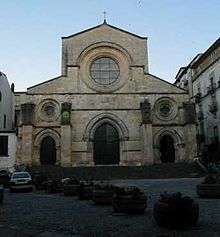
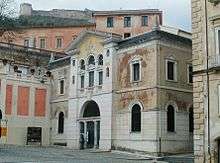
Main sights
Church of San Domenico
Founded in 1448, the church combines Renaissance and Medieval elements. Its most interesting feature is the rose window defined by 16 little tuff columns. The wooden portal (1614) is inlaid with floral motifs, figures of saints and coats of arms.
Inside the church are works by the Cosentian painter A. Granata (late 18th century): Santa Rosa, Santa Caterina, San Ludovico, San Giacinto and San Domenico. The high altar is made of polychrome marble (1767). In the transept, there is a Deposition and a San Vincenzo Ferreri (late 18th century, anonymous). The sacristy is noted for its ribbed vault, a double lancet window with a narrow arch and a wooden choir installed in 1635.
The Cathedral
The exact origins of the Duomo are unknown; it was probably built during the first half of the 11th century. An earthquake destroyed the cathedral on 9 June 1184, and rebuilding was completed by 1222 when the cathedral was consecrated by Emperor Frederick II. At some point during the first half of the 18th century the church was covered by a baroque superstructure which obliterated the original structure and its works of art. In the first half of the 19th century the façade was transformed in neo-gothic style, which completely changed its character. At the end of the 19th century, Archbishop Camillo Sorgente entrusted the work to Pisanti, who recovered the original old arches and the ancient structure of the church. In the 1940s the work was finally completed. In the transept is the tomb of Isabella of Aragon, wife of king Philip III of France. A long aisle links the Duomo to the archbishops' palace, the Palazzo Arcivescovile, which houses an Immacolata by Luca Giordano. One can also admire the rare and precious Stauroteca, a gift from Emperor Frederick II to the Duomo upon consecration. The work was produced in the royal goldsmiths' workshops, better known as “Tiraz”, in a cultural environment which blended Arabic, Byzantine and Western cultural elements.
On the 12th of October 2011, the Cathedral of Cosenza received the status of UNESCO World Heritage Site for being "Heritage Witness to a Culture of Peace".[3][4] This is the first award given by UNESCO to the region of Calabria.
Monastero delle Vergini
In via Gaetano Argento stands the "Convent of the Virgins". The external part of the main entrance is made of decorated tuff, while the internal part is carved of wood. The convent contains a 16th-century painting of the Annunciation. In front of it, is the 13th-century Madonna del Pilerio attributed to Giovanni da Taranto, while on the walls are four other anonymous 16th-century paintings: the Visitation, the Circumcision, the Adoration of the Shepherds and the Adoration of the Magi. In the apse is the altarpiece Transit of the Virgin (1570). The cymatium houses a painting portraying the Coronation of the Virgin, while at the base of the two columns are paintings, attributed to Michele Curia, the "Master of Montecalvario", of two unidentified saints. The wooden choir dates to the 17th century.
Giostra Vecchia
In the fifteenth century, at Palazzo Falvo the Renaissance was introduced at Cosenza, in the Giostra Vecchia. Here are located the church and monastery of Saint Francis of Assisi. The Latin cross plan has a nave and two aisles. In the nave stands the impressive high wooden altar built in 1700. Above it is a painting by Daniele Russo representing the Perdono d’Assisi (1618). The left aisle is home to a wooden 17th-century crucifix, the altar of the Madonna della Febbre and the statue of the Madonna with Child, in marble, dating to the 16th century. The sacristy has a painted wooden ceiling, a wooden armadio representing episodes from the Passion of Christ and pictures of saints and Franciscan monks. The stone arch is characterized by the painting of St. Francis of Paola, while on the walls are some frescoes dating to the beginning of the 15th century.
Hohenstaufen Castle
.jpg)
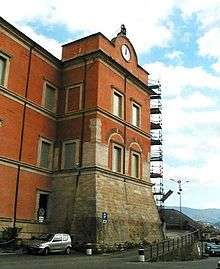
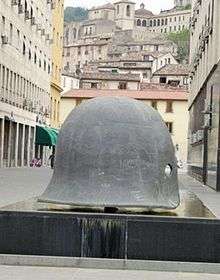
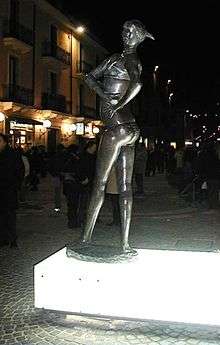
The Castello Svevo ("Swabian" or Hohenstaufen Castle) was originally built by the Saracens on the ruins of the ancient Rocca Brutia, around the year 1000. The castle was restored by Frederick II, Holy Roman Emperor, adding the octagonal tower to the original structure, in 1239. According to tradition, his son Henry lived in this castle, as a prisoner at his father’s command. Louis III of Naples and Margaret of Savoy married in the castle and they both settled there in 1432.
All signs of the ancient Saracen structure have now disappeared. In the internal cloister, the modifications made by the Bourbons in order to convert it into a prison can also be seen. The entrance-hall is covered by ogival arches with engraved brackets. A wide corridor is dominated by some fleur-de-lis from the House of Anjou coat of arms. They are engraved on the ribbed Hohenstaufen arches.
Spirito Santo
The church of Sant'Agostino, also known as the Spirito Santo, was built in 1507 by the Augustinians. The original portal has several inscriptions in Gothic characters. The interior has a series of paintings from the eighteenth century. Further on a narrow street leads to the so-called “Area of the Bandiera Brothers”, the Vallone di Rovito. Here, the insurrectional patriots of 1844 were executed by a firing squad.
San Francesco di Paola
In the Arenella, are the Church and Monastery of Saint Francis of Paola (1510). The interior, with a single nave, houses the tomb of Ottavio Cesare Gaeta. On the right wall, are two 18th-century paintings: a Sacra Famiglia and Madonna con San Francesco e Sant’Agostino. On an altar is a wooden statue of Saint Francis of Paola; while on the left side of the nave, on another altar, is a wooden statue of San Michele Arcangelo. The Madonna with Child in Glory and Saints Paul and Luke (1551) was painted by Pietro Negroni. In the apse, a 16th-century triptych made by Cristoforo Faffeo represents the Madonna and Child in glory with saints Catherine and Sebastian. At the back of the altar is a wooden choir built in 1679 by M. Domenico Costanzo da Rogliano. On the wall of the sacristy are remains of frescoes dating back to 1550-1600. On the vault are some pastels representing scenes from the life of the Saint from Paola.
San Salvatore
The small church of San Salvatore serves the parish which professes the Byzantine-Albanian faith. Inside the nave are a wooden ceiling, some frescoes of the Apostoli, of the Salvatore and of the Madonna, as well as a splendid iconostasis.
Open Air Museum
In the modern part of Cosenza, in an area stretching from the pedestrianized Corso Mazzini to Piazza Bilotti, lies the open-air "Museo MAB" (Museo all'aperto Bilotti). The museum hosts a wide range of modern art sculptures that stand in the street for residents and tourists. The sculptures were donated to the city by the Italian-American entrepreneur and art collector, Carlo Bilotti. They include Saint George and the Dragon by Salvador Dalí, Hector and Andromache by Giorgio de Chirico, "the Bronzes" by Sacha Sosno, The Bather by Emilio Greco, The Cardinal by Giacomo Manzù and various marble sculptures by Pietro Consagra.
Museums and cultural institutions
- National Gallery - Palazzo Arnone
- Civic Archeological Museum
- Remembrance Museum
- Bilotti Open Air Museum
- Rendano Theatre
- Morelli Theatre
- Acquario Theatre
- Cosentian Academy
- University of Calabria
- State Conservatoire of Cosenza
- State Archive Library
- Civic Library
- National Library
- District Library
- Children's Library
- Calabria Jazz Centre Recordings Archive
- Antonio Guarasci Foundation Library
- Church Library (SS. Crocifisso)
- Theological Library (Seminario cosentino)
- Cultural and Ethno-Anthropological Heritage Archive
Events and festivals
- Fiera di S.Giuseppe - March
- Festival delle Invasioni - July
- Festa del Cioccolato (Chocolate Festival) - October
- La sagra dell'uva e del vino (Wine Festival) in Donnici - October
Notable people
- Joachim of Fiore (theologian, c.1135-1202)
- Aulo Giano Parrasio (humanist, 1470–1521)
- Bernardino Telesio (philosopher, 1509–1588)
- Pietro Negroni (painter, 1505–1565)
- Antonio Serra (economist, late 16th century)
- Sertorio Quattromani (philosopher, 1541–1607)
- Francesco Saverio Salfi (writer, 1759–1832)
- Nicola Misasi (writer, 1850–1923)
- Alfonso Rendano (pianist, 1853–1931)
- Alessandro Longo (composer, 1864–1945)
- Pietro Mancini (politician, 1876–1968)
- Fausto Gullo (politician, 1887–1974)
- Stefano Rodotà (politician, born 1933)
- Maria Perrotta (pianist, born 1974)
- Stefano Fiore (footballer, born 1975)
- Maria Perrusi (Miss Italia 2009)
International relations
Twin towns – Sister cities
Cosenza is twinned with:
-
 Kenosha, Wisconsin, United States, since 1979[5]
Kenosha, Wisconsin, United States, since 1979[5] -
 Lansing, Michigan, United States, since 2000[6]
Lansing, Michigan, United States, since 2000[6] -
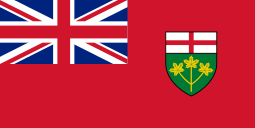 Sault Ste. Marie, Ontario, Canada, since 2010[7]
Sault Ste. Marie, Ontario, Canada, since 2010[7]
Gallery
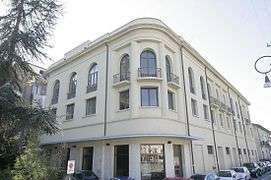 Morelli Theatre
Morelli Theatre- Steps in Via Arabia
- June Fountain
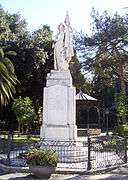 Statue in the Old Gardens
Statue in the Old Gardens- Church of San Domenico
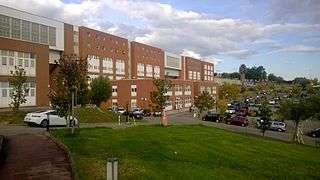 UNICAL University
UNICAL University- Night view
 View of the Old Town
View of the Old Town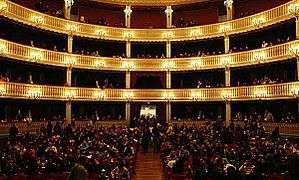 Interior of the Rendano Theatre
Interior of the Rendano Theatre View of the Old Town
View of the Old Town
References
- ↑ taken from "Annuario statistico italiano 2008" ISBN 978-88-458-1595-9
- ↑ Jordanes, De origine actibusque Getarum (551), taken up by Edward Gibbon, Decline and Fall of the Roman Empire, chapter 31.
- ↑ http://www.youritaly.com/Guide_Turistiche/CITIES_OF_ART/Cosenza_City
- ↑ http://en.italy-holiday.com/calabria/Cosenza
- ↑ City of Kenosha website
- ↑ "Living Here | Sister Cities | City of Lansing, Michigan". Lansingmi.gov. Retrieved 2013-03-26.
- ↑ http://www.cityssm.on.ca/contentadmin/UserFiles/File/Agendas_Minutes/2010/2010_03_08_Minutes.pdf
External links
| Wikimedia Commons has media related to Cosenza. |
- (Italian) Cosenza official website

